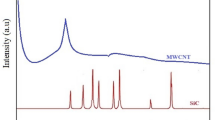Abstract
The effect produced by the short carbon fiber additive on the hydration of calcium aluminate cement under the ambient temperatures of 10, 20 and 30 °C is investigated. The calorimetric analysis of the cement paste has shown that the carbon fiber additive increases heat release and decreases the induction period of hydration at the ambient temperatures of 10 and 30 °C, while at the temperature of 20 °C, this period is increased. X-ray diffraction and thermal analysis have shown that carbon fiber additive does not have any influence on the composition of the formed hydrates; however, their amount depends on it. It has been also found that a dense layer of cement hydrates is formed around the fibers. Due to the positive effect of carbon fiber additive on cement hydration and microstructure, as well as its reinforcing effect, the compressive strength and the bending strength of cement stone are increased by 3–23 and 13–70 %, respectively, depending on the ambient temperature.










Similar content being viewed by others
References
Houssam A, Toutanjia HA, Korchia TE, Gary L. Leathermana GL, Katza NR. Tensile strength of carbon fiber reinforced cement composites. In: MRS Proceedings; 1991. vol. 245, p. 359.
Chung DDL. Cement reinforced with short carbon fibers: a multifunctional material. Compos Part B. 2000;31:511–26.
Wang C, Li K-Z, Li H-J, Jiao G-S, Lu J, Hou D-S. Effect of carbon fiber dispersion on the mechanical properties of carbon fiber-reinforced cement-based composites. Mater Sci Eng A. 2008;487:52–7.
Garces P, Frailea J, Vilaplana-Ortegob E, Cazorla-Amorós D, Alcocelc EG, Andióna LG. Effect of carbon fibres on the mechanical properties and corrosion levels of reinforced portland cement mortars. Cem Concr Res. 2005;35:324–31.
Fu X, Lu W, Chung DDL. Improving the bond strength between carbon fiber and cement by fiber surface treatment and polymer addition to cement mix. Cem Concr Res. 1996;26(7):1007–12.
Laukaitis A, Kerienė J, Kligys M, Mikulskis M, Lekūnaitė L. Influence of mechanically treated carbon fibre additives on structure formation and properties of autoclaved aerated concrete. Constr Build Mater. 2012;26:362–71.
Garcésa P, Zornozaa E, Alcocelb EG, Galaoa Ó, Andióna LG. Mechanical properties and corrosion of CAC mortars with carbon fibers. Constr Build Mater. 2012;34:91–6.
Gosselin C. Microstructural development of calcium aluminate cement based systems with and without supplementary cementitious materials. Ph.D. Thesis N 4443; 2009. p. 219.
Pacewska B, Wilińska I, Bukowska M. Calorimetric investigations of the influence of waste aluminosilicate on the hydration of different cements. J Therm Anal Calorim. 2009;97:61–6.
Pacewska B, Nowacka M, Wilińska I, Kubissa W, Antonovich V. Studies on the influence of spent FCC catalyst on hydration of calcium aluminate cements at ambient temperature. J Therm Anal Calorim. 2011;105:129–40.
Pacewska B, Wilińska I, Nowacka M. Studies on the influence of different fly ashes and Portland cement on early hydration of calcium aluminate cement. J Therm Anal Calorim. 2011;106:859–68.
Siauciunas R, Gendvilas R, Mikaliunaite J, Urbonas L. Heat flow and strength properties of perspective hydraulic binder material. J Therm Anal Calorim. 2015;121:57–65.
Gendvilas R, Siauciunas R, Baltakys K. Quantitative thermal analysis of α-C2SH as a precursor for low-energy cements. J Therm Anal Calorim. 2015;121:155–62.
Antonovič V, Kerienė J, Boris R, Aleknevičius M. The effect of temperature on the formation of the hydrated calcium aluminate cement structure. In: Procedia Engineering. 11th international conference on modern building materials, structures and techniques (MBMST). Amsterdam: Elsevier Science Ltd; 2013. vol. 57, p. 99–106.
Pacewska B, Nowacka M, Antonovič V, Aleknevičius M. Investigation of early hydration of high aluminate cement-based binder at different ambient temperature. J Therm Anal Calorim. 2012;109:717–26.
Antonovič V, Aleknevičius M, Kerienė J, Pundienė I, Stonys R. Investigating the hydration of deflocculant calcium aluminate cement-based binder with catalyst waste. J Therm Anal Calorim. 2012;109:537–44.
Chotard TJ, Bonceour-Martel MP, Smith A, Dupuy JP, Gault C. Application of X-ray computed tomography to characterise the early hydration of calcium aluminate cement. Cem Concr Compos. 2003;25:145–52.
Nilforoushan MR, Talebian N. The hydration products of a refractory calcium aluminate cement at intermediate temperatures. Iran J Chem Chem Eng. 2007;26(3):19–24.
Luz AP, Pandolfelli VC. Halting the calcium aluminate cement hydration process. Ceram Int. 2011;37:3789–93.
Кpaвчeнкo ИB. Глинoзeмиcтый цeмeнт [Kravchenko IB, Alumina cement]. Mocквa: Гocyдapcтвeннoeиздaтeльcтвoлитepaтypыпocтpoитeльcтвy, apxитeктype и cтpoитeльныммaтepиaлaм [Moscow: State Publishing House for construction, architecture and building materials]; 1961. p. 175.
Cardoso FA, Innocentini MDM, Akiyoshi MM, Pandolfelli VC. Effect of curing time on the properties of CAC bonded refractory castables. J Eur Ceram Soc. 2004;24:2073–8.
Nishikawa A. Technology of monolithic refractories. Japan: Plibrico Japan Company Limited; 1984. p. 598.
Ukrainczyk N, Matusinovic T, Kurajica S, Zimmermann B, Sipusic J. Dehydration of a layered double hydroxide—C2AH8. Thermochim Acta. 2007;464:7–15.
Author information
Authors and Affiliations
Corresponding author
Rights and permissions
About this article
Cite this article
Boris, R., Antonovič, V., Kerienė, J. et al. The effect of carbon fiber additive on early hydration of calcium aluminate cement. J Therm Anal Calorim 125, 1061–1070 (2016). https://doi.org/10.1007/s10973-016-5312-2
Received:
Accepted:
Published:
Issue Date:
DOI: https://doi.org/10.1007/s10973-016-5312-2




